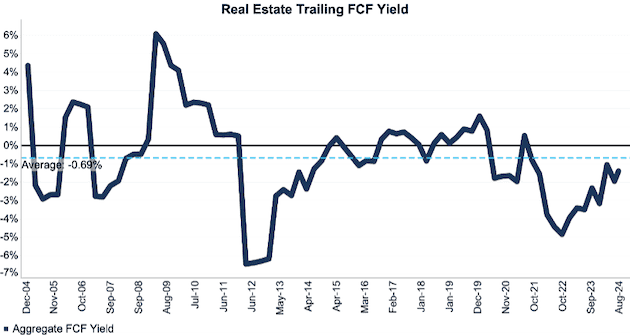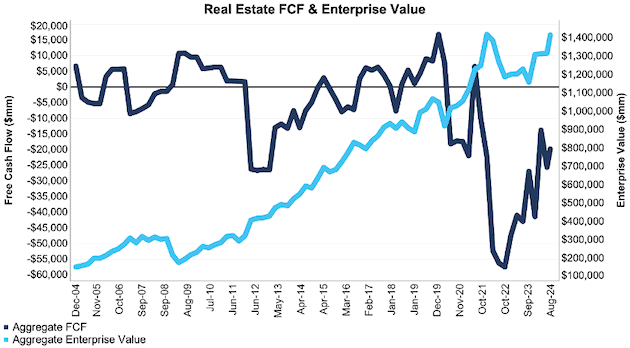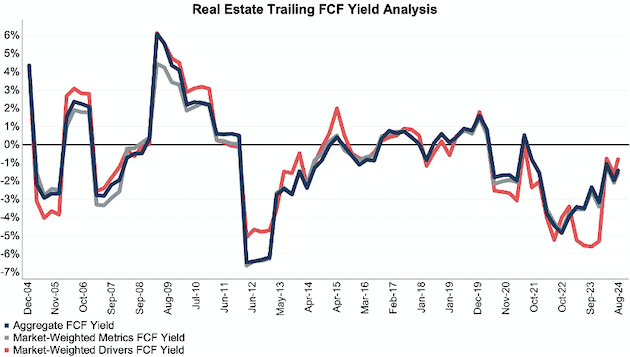We have updated the free cash flow (FCF) yield for the S&P 500 and all sectors through 8/15/24.
Over the last several quarters, we are seeing a clear trend in the S&P 500’s FCF yield. At the sector level, there is no clear trend, just mixed signals. Four sectors saw FCF yields go up while seven saw them decline – and to varying degrees.
This report is an abridged and free version of S&P 500 & Sectors: Free Cash Flow Yield Update for 2Q24, one of our quarterly series on fundamental market and sector trends. The full report is available to Institutional members.
The full version of this report analyzes[1],[2] FCF, enterprise value, and the trailing FCF yield for the S&P 500 and each of its sectors (last analysis is here).
This report leverages our cutting-edge Robo-Analyst technology to deliver proven-superior[3] fundamental research and support more cost-effective fulfillment of the fiduciary duty of care.
Trailing FCF Yield Analysis in 2Q24
Figure 1 in the full report shows the FCF Yield for the S&P 500 from December 2004 through 8/15/24. The full report provides the same details on FCF and Enterprise value for the S&P 500 and its eleven sectors.
Sneak Peak on Select S&P 500 Sectors
Investors are getting the highest FCF for their investment dollar in the Telecom Services sector as of 8/15/24. On the flip side, the Real Estate sector has the lowest trailing FCF yield of all S&P 500 sectors.
To give you a sense of what we show in the full report, we provide a snippet on the Real Estate sector, below.
The full report provides these details and charts on the S&P 500 and all sectors.
Sample Sector Analysis[4]: Real Estate
Figure 1 shows the trailing FCF yield for the Real Estate sector rose from 5/16/24 to 8/15/24.
Figure 1: Real Estate Trailing FCF Yield: Dec 2004 – 8/15/24
Sources: New Constructs, LLC and company filings.
The August 15, 2024 measurement period uses price data as of that date and incorporates the financial data from 2Q24 10-Qs, as this is the earliest date for which all the 2Q24 10-Qs for the S&P 500 constituents were available.
Figure 2 compares the trends in FCF and enterprise value for the Real Estate sector since 2004. We arrive at these numbers by adding up the individual S&P 500/sector constituents’ free cash flow and enterprise value. We call this approach the “Aggregate” methodology, and it matches S&P Global’s (SPGI) methodology for these calculations.
Figure 2: Real Estate FCF & Enterprise Value: Dec 2004 – 8/15/24
Sources: New Constructs, LLC and company filings.
The August 15, 2024 measurement period uses price data as of that date and incorporates the financial data from 2Q24 10-Qs, as this is the earliest date for which all the 2Q24 10-Qs for the S&P 500 constituents were available.
The Aggregate methodology provides a straightforward look at the entire S&P 500/sector, regardless of market cap or index weighting, and matches how S&P Global (SPGI) calculates metrics for the S&P 500.
For additional perspective, we compare the Aggregate method for free cash flow with two other market-weighted methodologies: market-weighted metrics and market-weighted drivers. Each method has its pros and cons, which are detailed in the Appendix.
Figure 3 compares these three methods for calculating the Real Estate sector’s trailing FCF yields.
Figure 3: Real Estate Trailing FCF Yield Methodologies Compared: Dec 2004 – 8/15/24
Sources: New Constructs, LLC and company filings.
The August 15, 2024 measurement period uses price data as of that date and incorporates the financial data from 2Q24 10-Qs, as this is the earliest date for which all the 2Q24 10-Qs for the S&P 500 constituents were available.
This article was originally published on August 29, 2024.
Disclosure: David Trainer, Kyle Guske II, and Hakan Salt receive no compensation to write about any specific stock, style, or theme.
Questions on this report or others? Join our online community and connect with us directly.
Appendix: Analyzing Trailing FCF Yield with Different Weighting Methodologies
We derive the metrics above by summing the individual S&P 500/sector constituent values for free cash flow and enterprise value to calculate trailing FCF yield. We call this approach the “Aggregate” methodology.
The Aggregate methodology provides a straightforward look at the entire S&P 500/sector, regardless of market cap or index weighting, and matches how S&P Global (SPGI) calculates metrics for the S&P 500.
For additional perspective, we compare the Aggregate method for free cash flow with two other market-weighted methodologies. These market-weighted methodologies add more value for ratios that do not include market values, e.g. ROIC and its drivers, but we include them here, nonetheless, for comparison:
- Market-weighted metrics – calculated by market-cap-weighting the trailing FCF yield for the individual companies relative to their sector or the overall S&P 500 in each period. Details:
- Company weight equals the company’s market cap divided by the market cap of the S&P 500/ its sector
- We multiply each company’s trailing FCF yield by its weight
- S&P 500/Sector trailing FCF yield equals the sum of the weighted trailing FCF yields for all the companies in the S&P 500/sector
- Market-weighted drivers – calculated by market-cap-weighting the FCF and enterprise value for the individual companies in each sector in each period. Details:
- Company weight equals the company’s market cap divided by the market cap of the S&P 500/ its sector
- We multiply each company’s free cash flow and enterprise value by its weight
- We sum the weighted FCF and weighted enterprise value for each company in the S&P 500/each sector to determine each sector’s weighted FCF and weighted enterprise value
- S&P 500/Sector trailing FCF yield equals weighted S&P 500/sector FCF divided by weighted S&P 500/sector enterprise value
Each methodology has its pros and cons, as outlined below:
Aggregate method
Pros:
- A straightforward look at the entire S&P 500/sector, regardless of company size or weighting.
- Matches how S&P Global calculates metrics for the S&P 500.
Cons:
- Vulnerable to impact of companies entering/exiting the group of companies, which could unduly affect aggregate values. Also susceptible to outliers in any one period.
Market-weighted metrics method
Pros:
- Accounts for a firm’s market cap relative to the S&P 500/sector and weights its metrics accordingly.
Cons:
- Vulnerable to outlier results disproportionately impacting the overall trailing FCF yield.
Market-weighted drivers method
Pros:
- Accounts for a firm’s market cap relative to the S&P 500/sector and weights its free cash flow and enterprise value accordingly.
- Mitigates the disproportionate impact of outlier results from one company on the overall results.
Cons:
- More volatile as it adds emphasis to large changes in FCF and enterprise value for heavily weighted companies.
[1] We calculate these metrics based on S&P Global’s (SPGI) methodology, which sums the individual S&P 500 constituent values for free cash flow and enterprise value before using them to calculate the metrics. We call this the “Aggregate” methodology.
[2] This report is based on the latest audited financial data available, which is the 2Q24 10-Q in most cases. Price data is as of 8/15/24. QoQ analysis is based on the change since last quarter.
[3] Our research utilizes our Core Earnings, a more reliable measure of profits, as proven in Core Earnings: New Data & Evidence, written by professors at Harvard Business School (HBS) & MIT Sloan and published in The Journal of Financial Economics.
[4] The full version of this report provides analysis for every sector like what we show for this sector.



